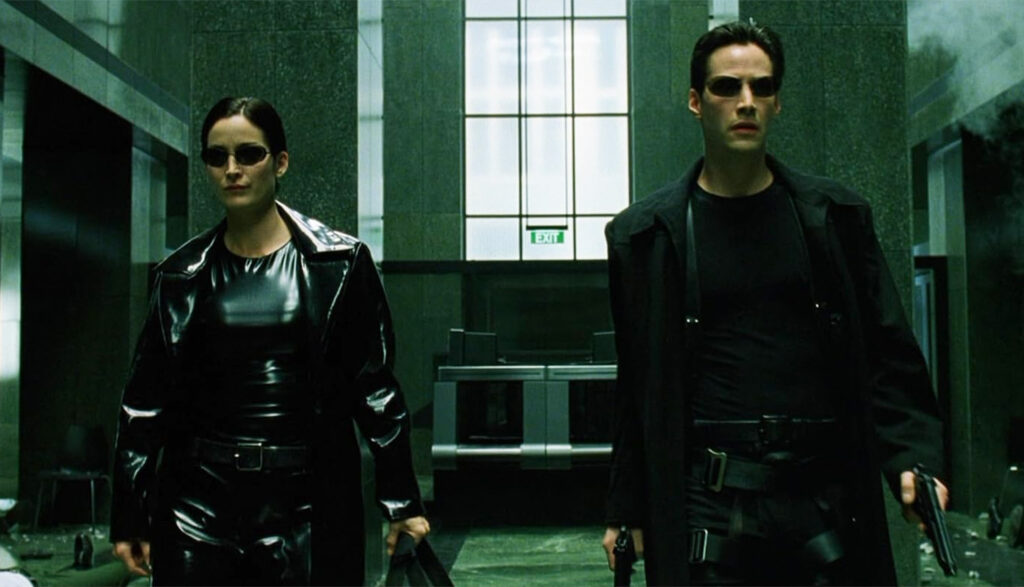
Another day, another morning in the supervisor’s office.
“You have a problem with authority, Mr. Anderson,” Mr. Rhineheart drones. “You believe you are special. That the rules do not apply to you.”
The programmer quietly takes the lecture. His employment at Meta Cortex depends on his acquiescence. His obedience. And let’s be honest, Thomas Anderson needs the job. His hobby doesn’t come cheap.
“Obviously, you are mistaken,” Mr. Rhineheart continues. “This company is one of the top software companies in the world because every single employee understands that they are part of a whole. Thus if an employee has a problem, the company has a problem.”
Oh, the company has a problem, all right. And if Mr. Rhineheart knew what Thomas did during his downtime—that Mr. Anderson was actually the notorious hacker known as Neo—Mr. Anderson wouldn’t be just out of a job, but on his way to prison.
“The time has come for you to make a choice, Mr. Anderson,” the lecture continues. “Either you choose to be at your desk on time from this day forth, or you choose to find yourself another job. Do I make myself clear?”
“Yes, Mr. Rhineheart, perfectly clear,” Mr. Anderson says.
Thomas Anderson walks out of the office and back to his cubicle—perhaps remembering why he was late. How he received a strange message to “follow the white rabbit.” How he followed that rabbit—a tattoo on a woman’s shoulder—to a nightclub, where a beautiful stranger walked up to him and started whispering about Morpheus and unanswered questions and, most critically, what is the matrix.
But Mr. Anderson doesn’t have much time to ponder that hours-old conversation. He receives a mysterious call from someone that encourages him to start running.
NOW.
“They are coming for you, Neo,” the voice says over the phone, “and I don’t know what they’re going to do.”
Looks like Mr. Anderson, Neo, does have a choice to make. And then another, and another, and another. And those choices will not just impact Neo’s life, but the world itself.
Watched the movie? Read the review? Want to go deeper? Check out our Rewind video below, where Adam Holz and Paul Asay talk about The Matrix.
That world is not what Neo thought it was. It is a fiction, created by the machines and computers that now rule a decimated planet. And in perhaps The Matrix’s most famous scene, Neo is given a choice: Take a blue pill, and the gray-but-comfortable world he’s always known will return. Take the red pill, and he will know the truth.
He chooses truth, and that’s worth a bit of praise right from the get-go. It’s an uncomfortable truth (as they so often are). But when Neo and his pals choose to follow reality, rather than slip into a semi-comfortable fiction, they’re taking a step toward changing it. We learn that the world is filled with many humans waging a sort of guerilla war against their oppressors, risking their lives to do so.
But change is hard, too. It requires work and dedication and, most of all, sacrifice. We see that sacrificial attitude on display often, but no more so when Neo makes one of his most critical choices. He’s told that someone will sacrifice his very life for him—unless Neo chooses to sacrifice his own life for that person. Both characters show a willingness to give that ultimate gift.
The Matrix is filled with many religious—and often Christian—allusions, both overt and subtle. For those who want to take a deep dive on those references, check out the video embedded above. But for those looking for a briefer overview, here we go.
Neo sells some illicit computer disks, almost as if they were drugs, at his front door. The man who’s buying calls Neo “my own personal Jesus Christ,” which proves to be both sacrilegious and a bit of foreshadowing to Neo’s role in the film. Morpheus, the man who gave Neo a choice of pills to take, believes that Neo is “The One,” a prophesied messiah figure who can ignore the rules imposed by the Matrix and save humanity. That, and the sacrificial choice he’s faced with down the road, makes him a clear Christ-like figure—even if Neo himself harbors doubts. The character even undergoes a symbolic baptism of sorts (albeit in some pretty filthy water).
Those Christian echoes grow stronger when you consider the self-given name of the first rebel we meet: Trinity. (The apartment we first see her in is, fittingly, numbered 303. Neo’s apartment? 101.)
Morpheus’ belief that Neo is “The One,” and Neo’s resistance to that idea, serves as a central point of tension in an inherently spiritual conversation that has split many a Christian denomination: that tension between free will and fate. The movie has some interesting things to say about that tension—but it never answers its own questions.
Elsewhere, Morpheus is named for the Greek god of dreams. He takes Neo to the Oracle (referencing fortune tellers most famously from ancient Greece) to determine whether Neo’s the one. The ship he commands, named the Nebuchadnezzar, references a Babylonian king whose name was both historical and ripped right from the pages of the Bible.
The world of the Matrix, as mentioned, is a computer simulation. But because it is a simulation, the rules of reality can be bent—and that can look like magic. And the Matrix’s guardians—black-clad, sunglass-wearing “agents”—can take over the bodies of anyone who’s part of the Matrix, which feels very much akin to possession.
We also hear a reference to evolution.
While people think they’re living their regular ol’ lives, they’re actually being kept in womb-like pods. When Neo takes the red pill and is flushed out of the pod, we see his exposed rear for a split second. (He sometimes is seen shirtless elsewhere, too.)
Rebels must train to enter and deal with the Matrix. And to do so, Morpheus and his crew make use of stand-along computer simulations that they’ve mostly written themselves. One such simulation depicts a blond woman in an eye-turning red dress. When Neo leaves that simulation, another mate aboard the Nebuchadnezzar tells him that he can arrange a “much more personal” encounter with her. “To deny our own impulses is to deny the very thing that makes us human,” he adds. Another character looks at streams of code and says he doesn’t even see code anymore. “All I see is blond, brunette, redhead.”
A man aboard the Nebuchadnezzar hovers over and leers at a female shipmate, confessing his one-time desire for her. Characters kiss. Trinity wears some form-fitting garments, and other women don clothes that expose some skin. One character says she loves someone. There’s an allusion to masturbation.
One final note: The Wachowskis were known as “The Wachowski Brothers” when they directed The Matrix, but both identify as female now. That dual transition has led some to look for transgender themes within the film. Lilly Wachowski has said that the movie was intended as a transgender allegory (as reported to the BBC), but that “the world wasn’t quite ready.”
The Matrix is an unremittingly violent movie—and it makes violence look ever so cool, even beautiful at times. It’s easy to forget how many people are dying during these fight scenes—people who have innocently lived their pretend lives and who, in reality, die without ever seeing the outside of their computerized womb. We won’t detail every instance of violence, but I do want to point out some of the most notable moments.
The single most violent moment in the film—likely the scene that scored its R rating—is a point-blank gunshot in the head. It’s not particularly gory, at least not by 21st-century standards, but it is graphic and jarring.
Also difficult to watch: the brutal torture of a member of the Nebuchadnezzar. Matrix agents have clearly done a number on the guy. His face shows plenty of evidence of that abuse, and blood and drool oozes from him.
We hear a bit about the backstory of how the machines took charge. “We don’t know who struck first, us or them,” Morpheus tells Neo. “But we know it was us who scorched the sky.” The scorching was done in an effort to “kill” the solar-powered machines, but the machines quickly adapted. The reason why humanity survives is to serve as human “batteries” for them. And we’re told that when a human dies, the remains are fed, obliviously, to the sleeping others.
Physically detaching from the machine’s systems proves to be a painful process. When Neo wakes up, he pulls plenty of umbilical-like tubes out of his bare skin. Then, aboard the Nebuchadnezzar, he suffers yet more alterations. While still apart of the Matrix, agents erase his mouth, then allow a huge, insect-like tracker to burrow into his gut. When Morpheus and his clan find Neo, they grotesquely suck the thing out of his belly button and destroy it.
Neo engages in several spectacular fight sequences: He spars with Morpheus (offering an homage to Bruce Lee as he does so) and tangles with the Matrix’s agents in highly choreographed, almost liquid fight sequences. The fights do leave participants bloodied, and sometimes much worse.
Several people die aboard the Nebuchadnezzar, mostly as a traitor unhooks them while they’re in the Matrix. Because if you die in the Matrix, you die in real life, too. The real victims are seemingly unconscious when they’re killed. Their Matrix-inhabiting counterparts simply fall down dead.
People are shot to death and blown up. One guy is shot several times and left for dead. Knives and chokeholds make appearances. One character is hit by a train, and another nearly suffers the same fate. Someone seems to explode from the inside. People crash through walls.
About a dozen s-words and a good galosh of other profanities, including “a–,” “crap,” “h—” and the British crudity “bloody.” God’s name is misused five times, four with the word “d–n,” and Jesus’ name is abused thrice.
The man who buys the disk from Neo at the beginning expresses his affinity for the drug mescaline. The mates aboard the Nebuchadnezzar drink a strong alcoholic beverage that one says is “good for two things: degreasing engines and killing brain cells.” Someone quaffs fake wine in a fine fake restaurant. A character smokes a cigar.
Neo learns a host of martial arts as part of his training, including something called “drunken boxing.”
Neo messily vomits. The synthesized, soup-like gruel that the folks aboard the Nebuchadnezzar eat is compared to a “bowl of snot.”
As Morpheus offers Neo a choice between the red pill and blue, he tells Neo that he knows what it’s like to question the world around you. He knows what it feels like to look around and feel like a stranger in the world you were born in.
“It is this feeling that has driven you to me,” Morpheus says. “It is the world that has been pulled over your eyes to blind you from the truth.”
The Matrix is not a Christian movie. But I think that many a Christian might relate to that understanding of reality. Many a bumper sticker, many a scribbled poem echoes our own simple truth—one that feels curiously aligned with Neo’s own unfolding truth: We are not of this world.
This fallen planet of ours is not our home. Not if we’re Christians. Oh, we can see its beauty, enjoy its pleasures, even watch an occasional sci-fi movie and smile. But deep down, we know we’re meant for something more. We know we’re built for something else. We are God’s creatures, not the world’s. We are created in His image. And even as that fallen world whispers to us, lies to us, tells us this is all there is, we know better. We feel the truth deep, down in our toes.
The Matrix, originally released in 1999 to almost universal acclaim, hints at such things—perhaps intentionally sometimes, often less so. It might serve as a platter for many a conversation over tea and pie. And some might argue that the questions it raises about the dangers of AI are even more relevant than they were 25 years ago.
This film is a relatively mild R-rated movie, but its rating cannot be ignored. Its slavish glorification of violence cannot be excused. This story, for all its thoughtful interlacing of ideas, remains difficult and problematic watch as well.
The red pill, or the blue? When it comes to watching The Matrix, it’s wise to choose the red. Don’t go into the movie with a false sense of safety. Read the review and keep your eyes open. The truth is, this movie—whatever its merits—isn’t for everyone.


Paul Asay has been part of the Plugged In staff since 2007, watching and reviewing roughly 15 quintillion movies and television shows. He’s written for a number of other publications, too, including Time, The Washington Post and Christianity Today. The author of several books, Paul loves to find spirituality in unexpected places, including popular entertainment, and he loves all things superhero. His vices include James Bond films, Mountain Dew and terrible B-grade movies. He’s married, has two children and a neurotic dog, runs marathons on occasion and hopes to someday own his own tuxedo. Feel free to follow him on Twitter @AsayPaul.
Our weekly newsletter will keep you in the loop on the biggest things happening in entertainment and technology. Sign up today, and we’ll send you a chapter from the new Plugged In book, Becoming a Screen-Savvy Family, that focuses on how to implement a “screentime reset” in your family!